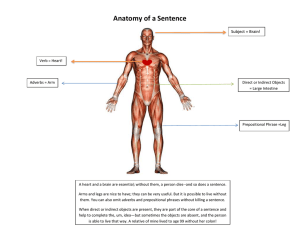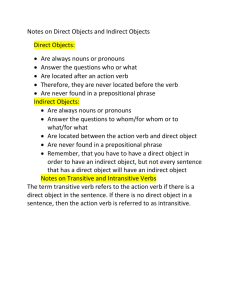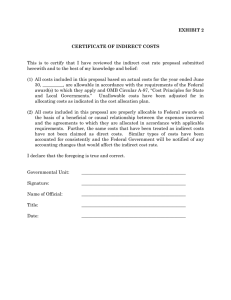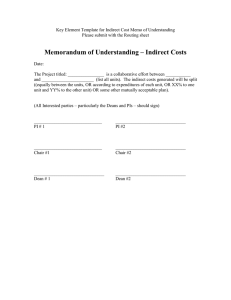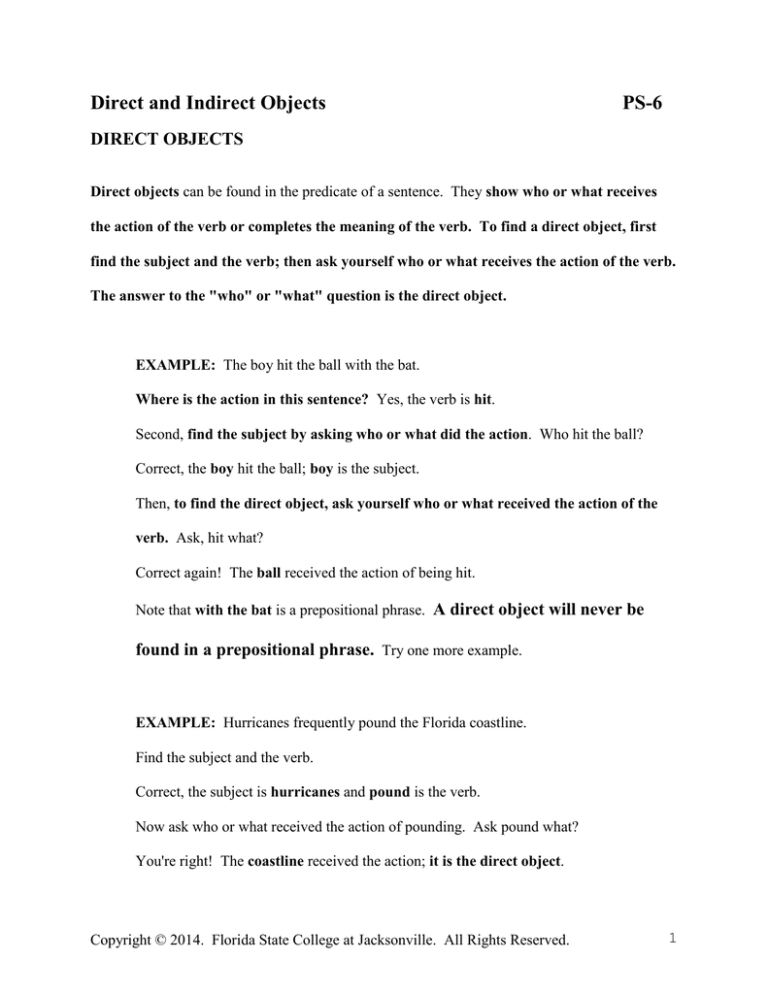
Direct and Indirect Objects
PS-6
DIRECT OBJECTS
Direct objects can be found in the predicate of a sentence. They show who or what receives
the action of the verb or completes the meaning of the verb. To find a direct object, first
find the subject and the verb; then ask yourself who or what receives the action of the verb.
The answer to the "who" or "what" question is the direct object.
EXAMPLE: The boy hit the ball with the bat.
Where is the action in this sentence? Yes, the verb is hit.
Second, find the subject by asking who or what did the action. Who hit the ball?
Correct, the boy hit the ball; boy is the subject.
Then, to find the direct object, ask yourself who or what received the action of the
verb. Ask, hit what?
Correct again! The ball received the action of being hit.
Note that with the bat is a prepositional phrase. A direct object will never be
found in a prepositional phrase. Try one more example.
EXAMPLE: Hurricanes frequently pound the Florida coastline.
Find the subject and the verb.
Correct, the subject is hurricanes and pound is the verb.
Now ask who or what received the action of pounding. Ask pound what?
You're right! The coastline received the action; it is the direct object.
Copyright © 2014. Florida State College at Jacksonville. All Rights Reserved.
1
Direct and Indirect Objects
PS-6
Two or more direct objects can form a compound direct object.
EXAMPLE: Joshua moved the table and chairs closer to the window.
What did Joshua move?
Correct! He moved both the table and chairs, a compound direct object.
Now you are ready to try the first practice exercise.
PRACTICE EXERCISE 1: Underline the direct object in each of the following sentences.
Remember that sentences may contain two or more direct objects.
1.
Karen gave a dog biscuit to the puppy.
2.
The ATM machine spewed money at the surprised young woman.
3.
The librarian carried the books and magazines to the researcher.
4.
Walking to school on a fall day, the children selected fallen leaves for show-and-tell.
5.
Sparta defeated Athens in the Peloponnesian War.
6.
The company hired a personable manager for its customer service position.
7.
The child needs a speech therapist to help her improve her enunciation.
8.
The people of China gave pandas to the people of the United States.
9.
Gary decorated the cake as a surprise for his family.
10.
Although she did not consider it a good influence, Jeanetta bought a new television for
the family room.
CHECK YOUR ANSWERS ON PAGE 5
Copyright © 2014. Florida State College at Jacksonville. All Rights Reserved.
2
Direct and Indirect Objects
PS-6
INDIRECT OBJECTS
Indirect objects are also found in the predicate and answer the question "to whom" or "for
whom." To identify an indirect object, first find the direct object and ask "to whom" or
"for whom" the direct object is intended.
EXAMPLE: The employees gave David a party to celebrate his promotion.
What is the direct object? What was given?
Correct! The direct object is party; it receives the action of the verb gave.
Now, ask yourself "to whom" or "for whom" the party was given.
Correct again!! The indirect object is David; the party was given for David.
Some helpful hints:
1.
An indirect object cannot exist without a direct object. The indirect object
must receive something from the direct object.
2.
Indirect objects usually are placed in front of a direct object.
3.
An indirect object will never be in a prepositional phrase.
EXAMPLE: Jessica bought her mother a new car.
Notice the word order of the sentence: mother is the indirect object and comes before the direct
object car.
Also notice that if the sentence had been reworded with a prepositional phrase, it would no
longer contain an indirect object.
Copyright © 2014. Florida State College at Jacksonville. All Rights Reserved.
3
Direct and Indirect Objects
PS-6
EXAMPLE: Jessica bought a new car for her mother.
Car is still the direct object, but the indirect object has been replaced with a prepositional phrase.
Now you try it.
PRACTICE EXERCISE 2: Underline the indirect object in each of the following
sentences. Remember that sentences may contain two or more indirect objects.
1.
Since you are going to the sale at Target, please buy me a set of sheets, too.
2.
The father bought the child an ice cream cone.
3.
The doctor gave his patients elastic bands for exercise.
4.
Jeremy gave his son a CD player and a stereo as a birthday gift.
5.
Carlotta brought her son a set of toy soldiers once owned by her grandfather.
6.
The reporters asked the mayor and the council many questions.
7.
The real estate agent sold my sister a colonial style mansion.
8.
The spa offered Maria and Antonio a full membership at half price.
9
The company will give you a refund if you are dissatisfied with the product.
10.
The instructor will provide the students assistance with their homework assignments.
Copyright © 2014. Florida State College at Jacksonville. All Rights Reserved.
4
Direct and Indirect Objects
PS-6
ANSWERS
PRACTICE EXERCISE 1
1.
biscuit
2.
money
3.
books, magazines
4.
leaves
5.
Athens
6.
manager
7.
therapist
8.
pandas
9.
cake
10.
it, television
PRACTICE EXERCISE 2
Indirect Object
Direct Object
1.
me
set
2.
child
cone
3.
patients
bands
4.
son
player, stereo
5.
son
set
6.
mayor, council
questions
7.
sister
mansion
Copyright © 2014. Florida State College at Jacksonville. All Rights Reserved.
5
Direct and Indirect Objects
8.
Maria, Antonio
9.
10.
membership
you
students
PS-6
refund
assistance
Copyright © 2014. Florida State College at Jacksonville. All Rights Reserved.
6

